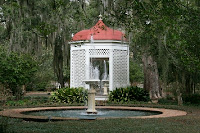 |
| Rosedown Plantation State Historic Site |
One of the best known and most beautiful of the South's historic antebellum plantation homes, historic Rosedown Plantation in St. Francisville has been a Louisiana landmark since 1834.
Named after a play its builders, Daniel and Martha Barrow Turnbull, saw on their honeymoon, Rosedown is now a state historic site and is open to the public year-round. In addition to preserving one of the finest collections of antebellum plantation structures in the nation, the park also preserves Rosedown's magnificent gardens which also date from the antebellum era.
Construction of the main house at Rosedown began in 1834. Framed by a beautiful avenue of live oaks, the facade of the Federal-Greek Revival style home is one of the most recognized in the South. Other surrounding plantation structures, including a doctor's office, kitchen, etc., were built in similar styles and many survive today.
 |
| Gardens at Rosedown Plantation |
Rosedown's magnificent gardens date back to at least 1836, when Martha Turnbull made the first entry in her "garden diary" that survives today. Over the decades that followed she created one of the largest private gardens of the 19th century, importing exotic plants from Asia and other overseas destinations. Rosedown, in fact, was the site of one of the first known plantings of camellias in America and blooms from the original stock can still be seen there. The 28-acre gardens are also known for their azaleas and other beautiful flowering plants.
 |
| Camellia at Rosedown |
The Turnbull family continued to live at Rosedown throughout the Civil War, despite the terrible violence that took place within earshot of the home during the Siege and Battle of Port Hudson. The home was not damaged during the shelling of St. Francisville by Union warships, although the arrival of Federal forces in the area meant freedom for the more than 100 slaves who lived and worked on the farm. After its fall in July of 1863, nearby Port Hudson became a major recruiting and training center for African American soldiers who came from area plantations to join the Union army.
Rosedown survived, however, and today is one of the most beautiful of the numerous historic plantations that line the Mississippi River from Natchez down to St. Francisville. To learn more, please visit
www.exploresouthernhistory.com/rosedown.













